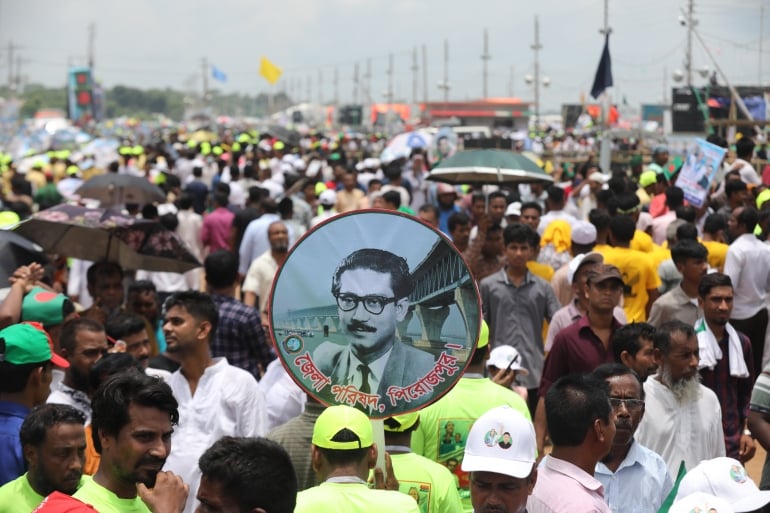Dhaka, Bangladesh – Prime Minister Sheikh Hasina inaugurated a historic bridge over the turbulent Padma River after years of delay due to corruption allegations that forced the World Bank to abandon the nearly $4 billion megaproject, which will connect the Bangladeshi capital Dhaka with the underdeveloped northwestern region. from the country.
The opening on Saturday of the eponymous Padma Bridge, Bangladesh’s longest bridge to date, which has been dubbed a “symbol of national pride”, marks a momentous occasion in the South Asian nation’s history.
Construction of the 6.15 km (3.82 mi) bridge began in November 2015 to connect 21 districts in the southwestern region of the country with Dhaka by road and rail, thus greatly reducing travel time.
It usually takes 15 to 22 hours to cover a distance of 180 to 300 km (111 to 186 miles) between the districts of the northeast region and Dhaka.
The double-layer steel truss bridge incorporates a four-lane highway on an upper level along with a single-track railway on the lower level.
Costing $3.87 billion to build, this is one of the largest mega-projects Bangladesh has ever undertaken and the entire amount is funded by the Bangladesh government.
In 2012, the World Bank had pulled out of a $1.2 billion loan deal for the project following allegations of corruption. Following suit, other donors, including the Asian Development Bank (ADB) and the Japan International Cooperation Agency (JICA), have also withdrawn from the project.
Hasina, who spearheaded efforts to build the bridge, declared that her government would self-finance the project.
His decision faced a battery of skepticism from the country’s economists, as well as political opponents, as Bangladesh had no experience in building mega-infrastructure without financial support from multilateral donors.
“Some people said we would always be indebted to others, but our father of the nation, Bangabandhu, Sheikh Mujibur Rahman, taught us the importance of self-respect,” Hasina said, addressing a sea of people on Saturday.
Sheikh Rahman was the founding father of Bangladesh who led the movement to secede from Pakistan in 1971.
“This Padma Bridge is not a pile of bricks and mortar, but a symbol of the pride, honor and capability of Bangladesh,” he said.
“We have shown the world that we can.”
A marvel of engineering
Calling it an “engineering marvel”, experts say the construction of the bridge is a major feat as the Padma is the most “treacherous and unpredictable” river after the Amazon River in South America.
China’s state-owned Railway Major Bridge Engineering Group (RMBEG) was tasked with leading the construction of the bridge with the help of some 1,200 engineers from Bangladesh.
With steel piles driven 400 feet (122 meters) deep into the river bed, Padma Bridge holds the record for the deepest piles of any bridge in the world.
Bridge project manager Shafiqul Islam told Al Jazeera that the water flowing at Mawa point (one end of the bridge) every 20 seconds is equal to the total amount of water used in Dhaka city per day.
“After Amazon, Padma has the strongest current [roughness in water] in the world. So we had to go for piles that are the thickest and deepest in the world,” he said.

Mentioning another unique feature of the bridge, Islam said, modern pendulum friction bearings (FPB) have been used to support the steel superstructure and concrete pier foundation.
“Such supports have never been used anywhere in the world before and can withstand a magnitude 9 earthquake,” he said, adding that the bridge’s supports can withstand more than 10,000 tons, exceeding the limit of any other structure in the world.
Islam said facing a plethora of engineering challenges, the cost of the project rose to almost three times the initial estimate of $1.2 billion.
“In addition, the devaluation of the Bangladeshi Taka currency has played a major role in increasing the cost, as more than half of the project expenses have been paid in foreign currency.”
Why a significant structure?
Located about 68 km (42 miles) from Dhaka, the Padma Bridge will serve as a gateway to the southwestern region of the country, significantly reducing travel time between Dhaka and major districts in the south-east, including Khulna, Jessore and Barishal.
It will also reduce the distance between Dhaka and Bangladesh’s second largest seaport, Mongla, by 100 km (62 miles).
The mighty Padma separates the southwestern region from Dhaka, and people are forced to travel by ferries or slow-moving speedboats. Perishables transported to Dhaka from the southwestern districts by truck often rot as the long journey can take 22-24 hours due to the long queue at ferry stations.
According to a study by the government’s Bridge Division, the Padma Bridge will save a total of 187,727 ferry waiting hours per day for 2,620 vehicles. It is estimated that with the opening of the bridge, around 24,000 vehicles will cross the river every day, a significant jump from the current 2,620.
The study also noted that the economic impact of the bridge will help increase the annual gross domestic product (GDP) of the Southwest region by 2.5 percent and the country’s overall GDP by more than 1.23 percent.
Economist Selim Raihan, who conducted a study on the economic impact of the bridge, said that its main benefit is that it will connect the southwestern districts, known for fishing and agriculture, with the economic lifeblood of Bangladesh – the Dhaka-Chattogram economic corridor. .
“As communication and transportation over the Padma River relied solely on ferries, there hasn’t been much industrialization in the southwestern districts so far,” he told Al Jazeera.
“The garment sector, Bangladesh’s most prominent industry and main source of export earnings, has been completely absent from those districts.”
“I think investors and industrialists will be interested in investing there, which will lead to massive economic growth.”
Reference-www.aljazeera.com